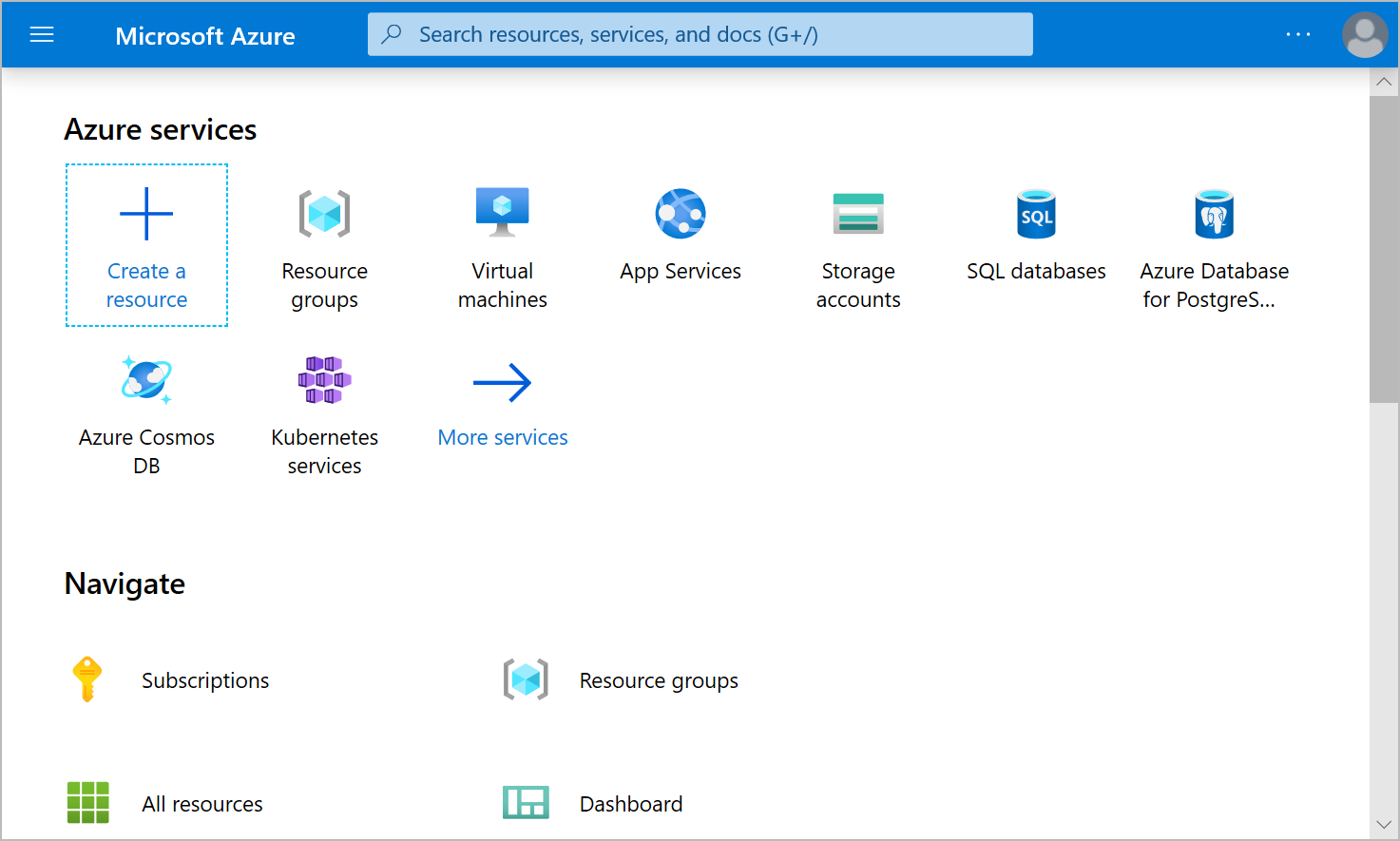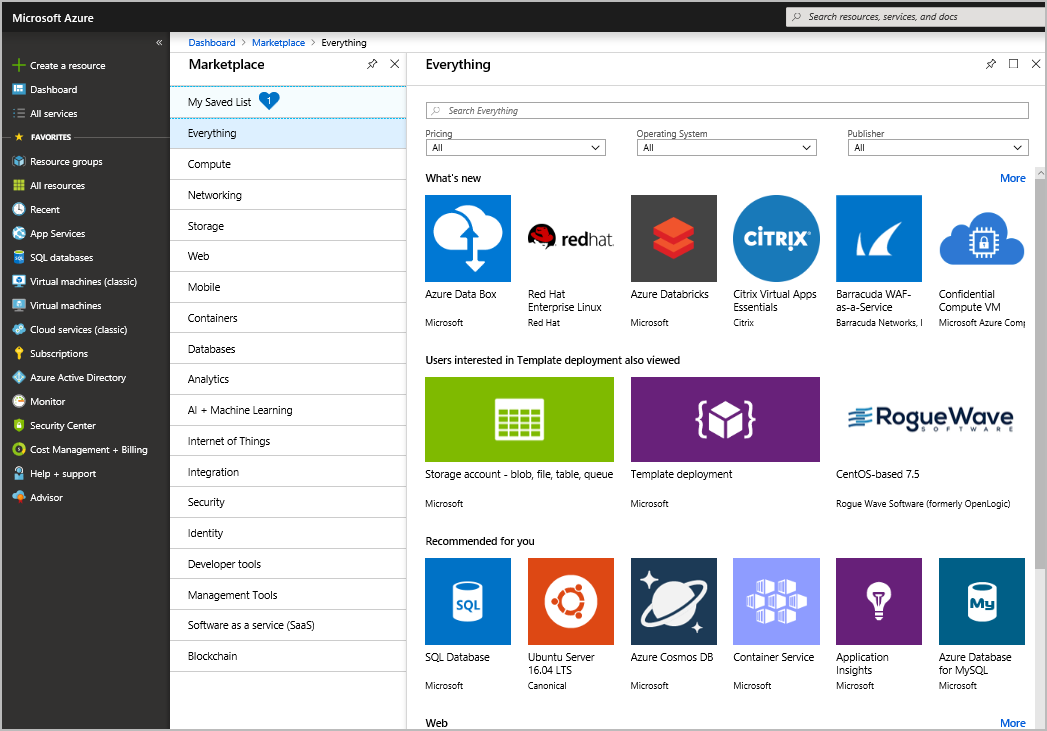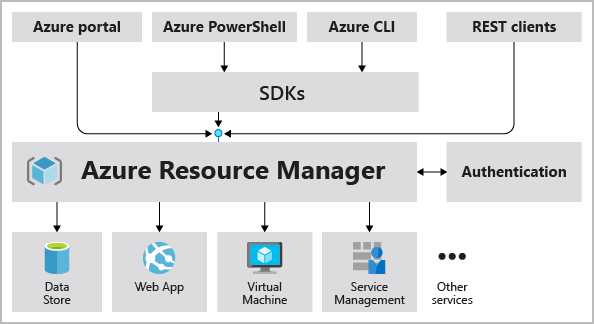These are the notes from the Microsoft's course on Cloud Computing. All the credit for the info goes to Microsoft, and all the credit for the effort goes to me.
Note: since it is based off of Microsoft's course, the material is tightly tied to Azure.
Describe Core Concepts
The first part, Introduction to Fundamentals, introduces the basics of cloud computing and Azure. The advantages of using cloud computing services and differentiation between the categories and types of cloud computing is discussed in Discuss Fundamental Concepts. Describe Core Azure Architectural Components examines concepts, resources, and terminology necessary to work with Azure architecture.
Introduction to Fundamentals
What is Cloud Computing?
Cloud computing is the delivery of computing services over the internet which is known as the cloud.
The services are:
- compute power (how much processing your computer can do)
- storage (the volume of data you use on your computer)
You use the services provided on a computer which is somewhere in the cloud provider's datacenter. It is a way to rent computing power and storage from someone else's computer.
Why is cloud computing usually cheaper to use?
You only pay for the resources you use without worrying about managing the upkeep of the computer, so it is economically efficient or cost effective. Cloud computing allows for a flexible resources and cost effective scaling. Typically, cloud computing:
- Lowers operating costs
- Helps to run infrastructures efficiently
- Allows for efficient scaling
What is Azure?
Azure is a set of cloud services provided by Microsoft. It supports infrastructure, platform, and software as the service computing. They are pay-as-you-go services.
How does it work?
Azure uses virtualization. There is an abstraction layer called a hypervisor that separates the hardware and the operating system. The hypervisor emulates all the functions of a real computer in a virtual machine optimizing the capacity of the abstracted hardware. It can run many VMs with different OSs such as windows or linux. There are numerous datacenters in Microsoft, and each datacenter has many servers, and each server has a hypervisor that can have many different VMs on it. Each server runs a fabric controller on it. Each fabric controller is connected to the orchestrator that is responsible for managing everything that happens in azure including responding to user requests. User makes requests using the orchestrators Web API that can be called by many different tools. When a user makes a request to create a VM, orchestrator packages what's needed, sends request to the fabric controller which creates a VM. Once FC created a VM, the user can connect to it.
What is Azure Portal?
Azure Portal is a GUI web-based console that provides an alternative to command-line tools. It lets you create, configure, and control your Azure services and subscriptions.

What is Azure Marketplace?
Azure Marketplace is a tool using which customers can browse, try, and buy applications and services optimized to run on Azure from Microsoft partners, independent software vendors, and startups.

What are Azure Services?
There are a lot of services available on Azure. Here are some most common categories of services:
- Compute - scale your computing capabilities on demand
- Networking - connect the cloud and on-premise infrastructure
- Storage - scale your data and up storage needs securely
- Mobile - build and deploy native apps
- Databases - bring databases to the cloud
- Web - build, deploy, manage, and scale web applications
- IoT - connect, monitor, and manage IoT assets as well as analyze the incoming data
- Big Data - run analytics on a massive scale
- AI - use existing data to forecast future behavior; build, train, and deploy ML models
- DevOps - create build and release pipelines to provide continuous integration, delivery and deployment
Describe Core Azure Architectural Components
Overview of Azure subscriptions, management groups, and resources
The organizing structure for resources in Azure has four levels: management groups, subscriptions, resource groups, and resources.

-
Resources are the instances of services you create such as VMs, storage, databases, etc.
-
Resource groups are the groups of resources (duh) which act as logical containers. They cannot be nested.
It makes sense to group resources in a logical manner. Organizing resources by life cycle can be useful. Resource groups have role-based access control (RBAC) permissions.
Azure Resource Manager is the deployment and management service for Azure. When a user sends a request, Resource Manager receives it. It authenticates and authorizes the request and sends it to the Azure service, which takes the requested action.

-
Subscriptions group together user accounts and the resources that have been created by the user accounts. It allows you to provision resources. It is a logical unit of Azure. There are two types of boundaries that can be defined around Azure products, services, and resources with subscriptions:
- Billing boundary: you can create multiple subscriptions for different types of billing requirements.
- Access control boundary: applies access-management policies at the subscription level.
-
Management groups help manage access, policy, and compliance for multiple subscriptions.
Azure regions, availability zones, and region pairs
Resources are created in regions. Region is a geographical area that contains one or more datacenters and networked together with a low-latency network. Azure has more global regions than any other cloud provider. They give the user flexibility, better scalability, and redundancy.
Availability zones are physically separate datacenters within a region. It is set up to be an isolation boundary. Availability ones ensure redundancy to protect information in case of failure. They are connected through high-speed, private fiber-optic network.
Region Pairs are created in the event if a large disaster affects two datacenters. Each Azure region is connected to another region within the same geography at least 300 miles away. This allows for replication of resources.

Describe Core Azure Architectural Components
Overview of Azure subscriptions, management groups, and resources
The organizing structure for resources in Azure has four levels: management groups, subscriptions, resource groups, and resources.

-
Resources are the instances of services you create such as VMs, storage, databases, etc.
-
Resource groups are the groups of resources (duh) which act as logical containers. They cannot be nested.
It makes sense to group resources in a logical manner. Organizing resources by life cycle can be useful. Resource groups have role-based access control (RBAC) permissions.
Azure Resource Manager is the deployment and management service for Azure. When a user sends a request, Resource Manager receives it. It authenticates and authorizes the request and sends it to the Azure service, which takes the requested action.

-
Subscriptions group together user accounts and the resources that have been created by the user accounts. It allows you to provision resources. It is a logical unit of Azure. There are two types of boundaries that can be defined around Azure products, services, and resources with subscriptions:
- Billing boundary: you can create multiple subscriptions for different types of billing requirements.
- Access control boundary: applies access-management policies at the subscription level.
-
Management groups help manage access, policy, and compliance for multiple subscriptions.
Azure regions, availability zones, and region pairs
Resources are created in regions. Region is a geographical area that contains one or more datacenters and networked together with a low-latency network. Azure has more global regions than any other cloud provider. They give the user flexibility, better scalability, and redundancy.
Availability zones are physically separate datacenters within a region. It is set up to be an isolation boundary. Availability ones ensure redundancy to protect information in case of failure. They are connected through high-speed, private fiber-optic network.
Region Pairs are created in the event if a large disaster affects two datacenters. Each Azure region is connected to another region within the same geography at least 300 miles away. This allows for replication of resources.
